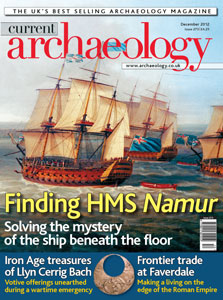HMS Namur brings a new meaning to a ‘ship burial’. Conjuring images of Sutton-Hoo style splendour, the boat is normally just an eye-catching status-symbol for the deceased. But not at The Historic Dockyard Chatham. The discovery of a quarter of a Royal Navy warship buried beneath flooring has puzzled archaeologists for over a decade. Now that the identity of the vessel is known, questions are being asked about whether her astonishing exploits over 47 years prompted her preservation in an unofficial memorial.
Traditionally the massive Roman military build-up in northern England is seen as stunting civilian activity and condemning the natives to abject poverty. The surprise discovery of a trading village at Faverdale is helping change this. Here, North East entrepreneurs seized the commercial opportunities of the military market, and even invested in a miniature bathhouse.
More recent military needs are to thank for the haul of Iron Age artefacts from the Llyn Cerrig Bach. When windblown sand started clogging aircraft engines at a nearby airfield during the Second World War, the pool was drained for peat to hold the dunes in check. This revealed a rich array of weapons, tools and ornaments, and an insight into Anglesey life around the eve of the Roman conquest.
Finally we examine the Tavistock Canal. Only running for 4 Ω miles, what this engineering marvel lacked in length it made up for in innovation. Recent survey has shed new light on a watercourse that witnessed the birth of many of the transport advances we take for granted today.
We are also delighted to announce that next year’s Current Archaeology Live! conference will take place at London’s Senate House in partnership with the Institute of Classical Studies on 1st and 2nd March. More details in future issues, but see p.41 for how to book. It would be great to see you there.
FEATURES/n
Finding HMS Namur/n
Solving the mystery of the ship beneath the floor
Why was an 18th-century flagship buried under a building at The Historic Dockyard, Chatham, and how was it identified?
ROMAN FAVERDALE
/n
A frontier trading settlement
What did the Romans do for the North East? Recent excavations suggest the development of a stable frontier opened new opportunities for the native population.
THE RIDDLE OF THE LAKE/n
Llyn Cerrig Bach and Iron Age Anglesey
From musical instruments to a slave chain, what can we learn from an astonishing array of prehistoric metalwork dredged from a Welsh bog?
TAVISTOCK CANAL/n
Surveying a forgotten marvel of the Industrial Age
What do eight years of research tell us about this pioneering site, once at the forefront of engineering innovation?
/n
NEWS/n
Potted prehistory; Stonehenge’s cutting-edge artwork; Roman redecorating; An Iron Age step up; Crossrail’s ancient track; Piecing together the jigsaw mummies; Iberian origins for the Newport Ship?; Defence Archaeology marches on; Relocating the Place of Killearn
REGULARS/n
Context
A Pict-and-mix selection of Iron Age barrows at Meigle, Perthshire
Reviews
A Gazetteer of Prehistoric Standing Stones in Great Britain; Visualising the Neolithic; Iron Age Ritual; Beyond the Dead Horizon
Sherds
Chris Catling’s irreverent take on heritage issues.
Special Report
What now for Birmingham’s Institute of Archaeology and Antiquity?
Odd Socs
Circulus Latinus Londoniensis

